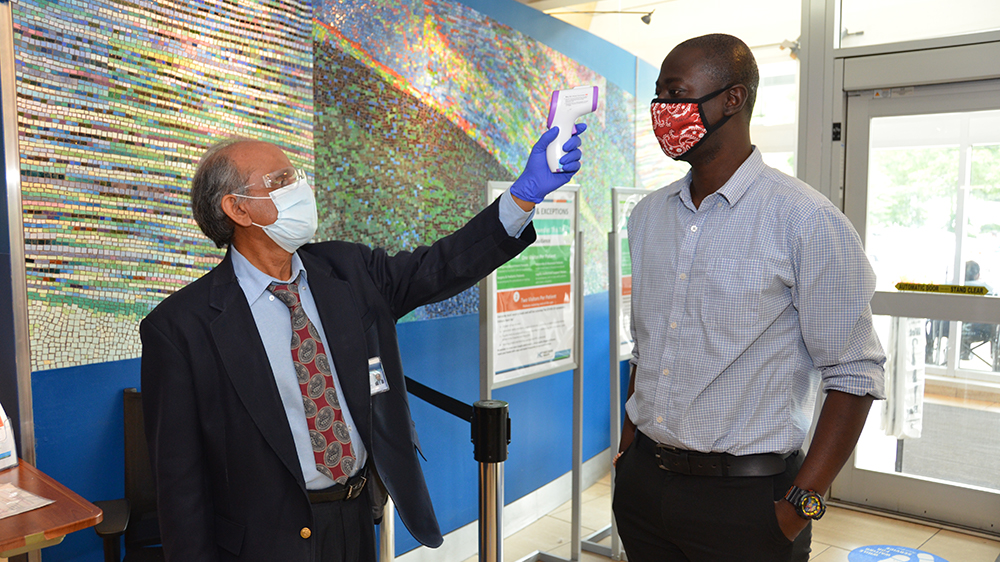Having been in isolation (or close to it) for many months, the urge to go out and “get back to normal” is easy to understand. The question is no longer can you go out; the question is should you. The Centers for Disease Control and Prevention has some thoughts.
There’s no way to ensure zero risk from resuming activities. That said, it’s important to understand and weigh the potential risks, so that if you do get out and about, you can take reasonable measures that protect yourself and your family and help reduce the spread of COVID-19.
Start by asking some questions
Generally speaking, the more closely you interact with other people, and the longer that interaction lasts, the higher the risk you may contract or spread the virus. So, before you go out, ask yourself these questions:
Am I, or is someone I live with, at risk for severe illness?
If you or someone in your household has an underlying medical condition or other serious COVID-19 risk factors, you need to take extra precautions to minimize those risks. That may mean avoiding going out altogether.
Is COVID-19 spreading in my community?
Local and state health departments are publishing daily reports to help keep us informed about case counts and trends in our communities. If the virus is still active in yours, be more cautious. View the COVID-19 dashboards for Montgomery County, Prince George’s County and the state of Maryland.
What are the local orders in my community?
Just because you’d like to go out doesn’t mean you should. Be sure to know the local restrictions in place in your community and follow them as closely as possible. Read the latest orders in effect for Montgomery County, Prince George’s County and the state of Maryland.
Will my activity put me in close contact with others?
If the answer is yes, can you practice physical distancing (staying at least six feet away from others), wear a cloth face covering, or participate outdoors? Those circumstances will help make it easier to justify your participation in the activity.
How many people will I interact with?
The more people you come across, the higher the risk – especially when those people aren’t familiar to you and may be carrying the virus without showing symptoms themselves.
How long will I be interacting with people?
Spending more time with others who may be infected increases your own risk of becoming infected. And if you’re infected and don’t know it, this raises their risk as well.
Will I have to share any items or equipment with other people?
The virus that causes COVID-19 can remain on surfaces and be transmitted to others who come in contact with them. If you’re planning on going someplace where you’ll have to use shared items (such as gym equipment or sitting at a restaurant table), it’s important to know how thoroughly they’re cleaned and disinfected between uses. Check the business’ website before you decide.
How will I get where I’m going?
Like public places, public transportation and ride-sharing services can put you in close contact with others and the surfaces they’ve touched. Many of those services (such as the Montgomery County Department of Transportation, Prince George’s County Transit System and Washington Metropolitan Area Transit Authority) require wearing masks, so know the rules before you go.
Do I risk missing work?
If you are exposed to or contract COVID-19, you may be quarantined at home and will have to miss work. Is the activity you’re considering worth the health and financial risk to you and your family?
Are there alternate or different approaches to the activity?
Rather than plan to go aisle by aisle inside the grocery store or pharmacy, many stores offer online ordering, curbside pickup and dedicated shopping hours for at-risk shoppers, allowing you the ability to get the items you need while reducing contact with others.
Take precautions
If you’ve answered those questions, weighed the risks they present, and then decide it’s safe to go out, plan to take every possible precaution to protect yourself. That includes taking proactive actions like:
- Choosing outdoor activities whenever possible.
- Staying at least six feet away from others.
- Wearing a cloth face-covering whenever you’re sharing space with other people.
- Choosing places that follow safety and cleaning precautions and protocols.
- Washing your hands with soap and water or using hand sanitizer often and as soon as you get home.
The decision to venture out is different for everyone and depends on your unique circumstances. The bottom line is this: the more closely you interact with others and the longer you do, the higher the risk of getting and spreading COVID-19. So, if you do go out, choose your activities wisely and protect yourself and others when you do.
Our Holy Cross Health Partners providers are available to answer questions online at no cost to you and, if needed, send a treatment plan if you think you’ve been exposed to COVID-19 or are showing symptoms. Get started by completing our online COVID-19 assessment.
Resources
Holy Cross Health presents the information in this blog as a resource for our community. It is not intended to replace professional medical advice or to endorse any particular entity or service. Personal health problems should be brought to the attention of the appropriate health professionals.



